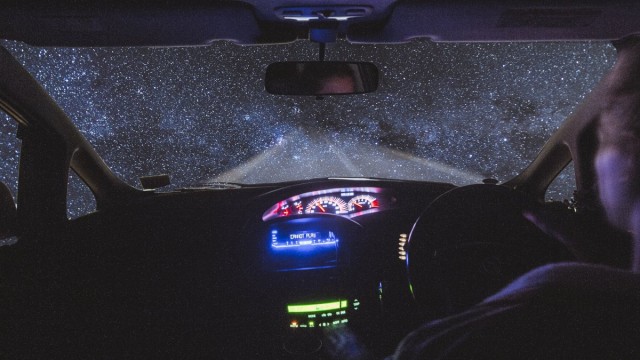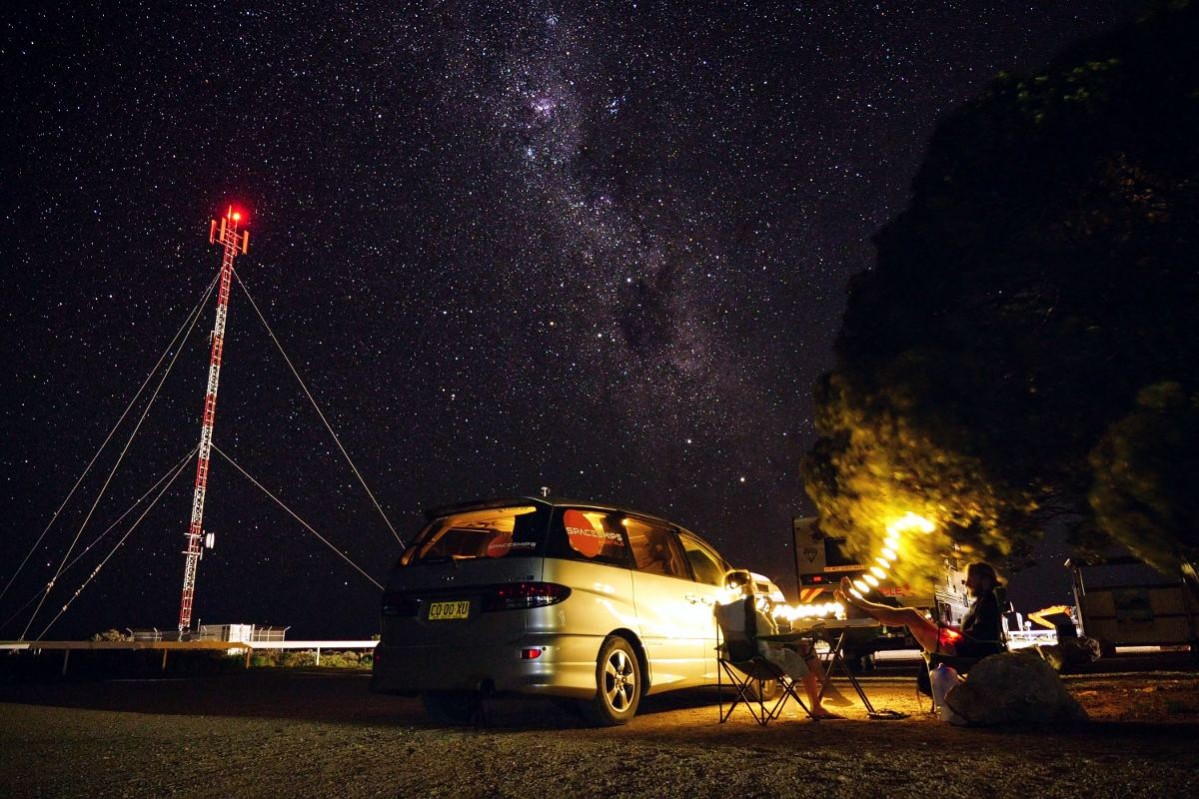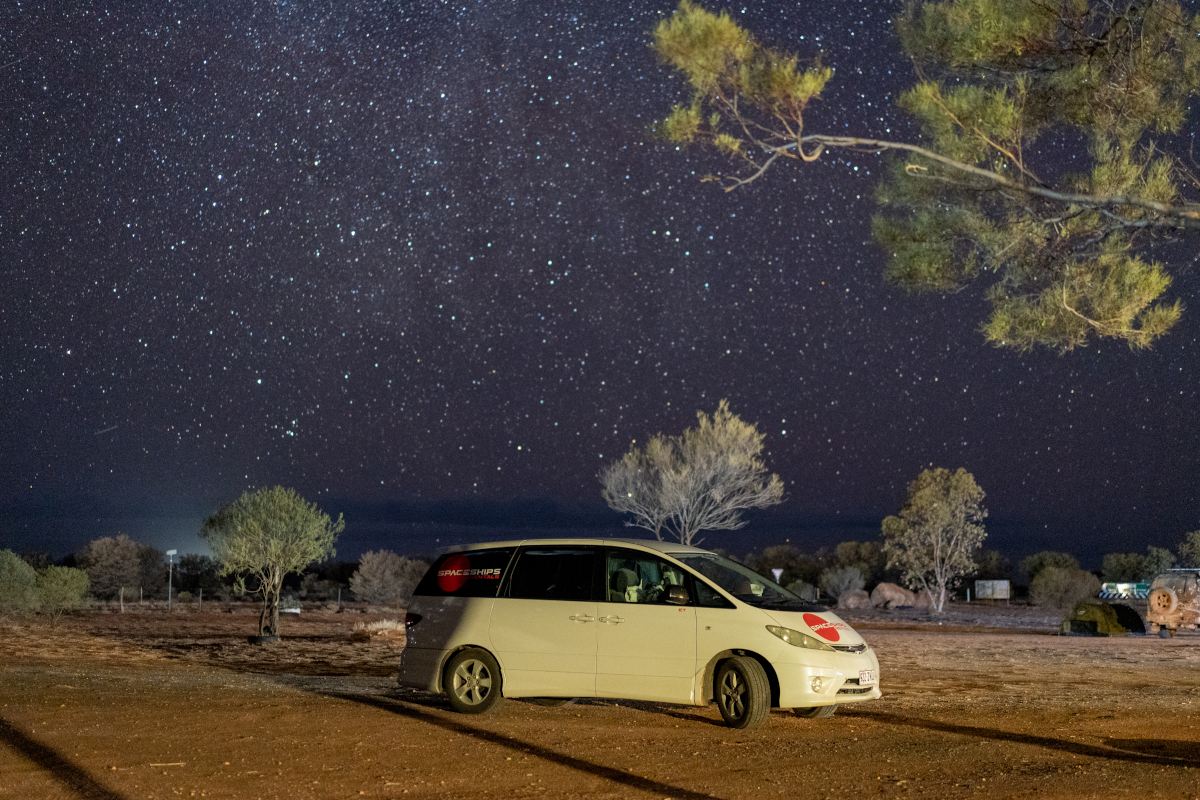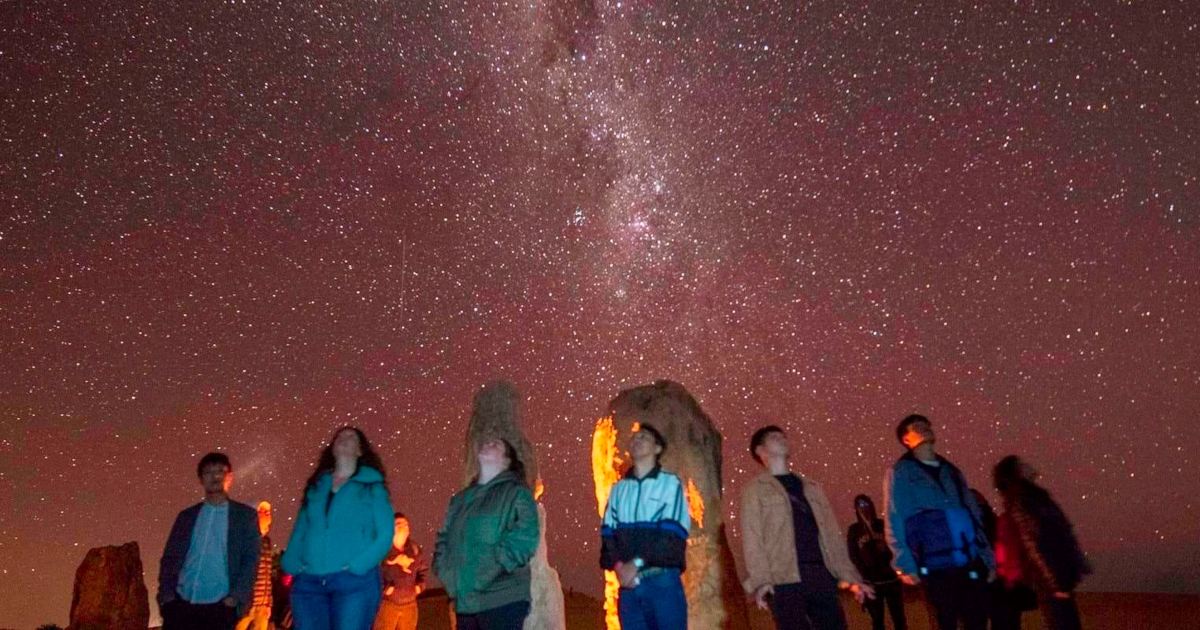Campervan Hire in Australia | 1300 132 469 or +61 2 8356 2900 or email

Hit enter to search or ESC to close

From Space Traveller to Stargazer, It’s All Possible on Your Aussie Road Trip
Posted by Mike | Spaceships Crew
"Where is your star? Is it far, is it far, is it far? When do we leave? I believe, yes, I believe" Oh yes, you better believe it as it is true. Australia is the perfect place for stargazing. Leave the densely populated cities and the light pollution in the Northern Hemisphere behind and blast off in a Spaceship to explore the outer space of Australia.
Your campervan will give you the unique opportunity to enjoy spectacular starry nights in Australia. Various remote locations have perfect stargazing conditions: big, dark skies and low light pollution. We’ll show you how you can blast off for the best stargazing in Australia.
See Southern Lights at Wilson’s Promontory (Victoria)
Ready for take-off from our Melbourne branch? It’s a 200km, 3-hour drive southeast down to Wilson’s Prom, the southernmost point of mainland Australia. The clear night shies down there on the coast can give you the chance to see the Milky Way in all its majesty, as well as the Aurora Australis, aka, the Southern lights. It's just like Northern Lights but on this side of the planet.
You can camp at Tidal River campground, but you will need to book in advance in the summer season. It’s worth it though – as well as having a useful camp store and on-site barbecues, it’s a great base to walk the secluded coastal walk and bushland trails on Wilson’s Promontory.
Take in a visit to Norman Beach with its excellent snorkelling in Australia’s largest Marine National Park with its amazing sponge gardens and eco-systems. Nature lovers will also see a wide variety of colourful fish, as well as fur seals, Little Penguins (the smallest Penguin in the world) and magnificent sea eagles.
Dark Sky Park at Warrumbungle National Park (NSW)
Head out northwest out of our Sydney depot, via the M1 then B84 Golden Highway to Coonabarabran in the Warrumbungle National Park. Warrumbungle is an indigenous Kamilaroi word meaning “Crooked mountains”, and you’ll see why when you visit.
This is Australia’s first official Dark Sky Park and its high altitude of over 500m above sea level, distance from cities and low light pollution give pristine skies, making it one of the top stargazing spots in Australia. This 23,000-hectare park is in the Orana region and is the best place in New South Wales to see the Milky Way in the night sky. There is an agreement with the residents of Coonabarabran to use low lighting at night to keep the Dark Sky Park free from light pollution.
It is also the location of the Sliding Spring Observatory, now run by the Research School of Astronomy & Astrophysics at the Australian National University, which houses Australia’s largest telescope, the 4m Anglo-Australian telescope. You can book day visits to the observatory as part of your trip to the park.
As well as stargazing it’s a great place to visit for great hiking and scenery. Stay at the well-equipped Camp Blackman to see heaps of wildlife including falcons and wedge-tailed eagles and for a great base to explore. Try the 14km Breadknife and Grand Tops High Walk – the Breadknife is a spectacular sandstone rock structure.

Campervan at campsite at night with a bright and starry night above
Outback, National Park & Island Skies (Queensland)
Just 100km and a couple of hours' drive south from our Brisbane depot is Lamington National Park. In winter the skies are clear with excellent celestial views. There are places to camp and lots of hikes and trails in the park too.
Going further afield, head for Charleville, 800km west of Brisbane in Outback Queensland. You can learn lots about traditional Aboriginal myths and legends regarding the stars and night skies. At the Cosmo Centre, you’ll get the chance to share in indigenous lore about the creatures that “live” in the night sky, like an Emu, and what the dark spaces traditionally mean from ancient tales.
For another amazing natural experience, head 360km south of Brisbane to K’Gari (Fraser Island). Its location, hundreds of miles from the mainland cities gives very low levels of light pollution, and you can see the Milky Way from your campsite or the beach.
You may also see the eerie phosphorous glow in the sea, where the water sparkles with an electric blue or green light. This natural phenomenon is called bioluminescence and occurs when small fish, crustaceans and particularly algae produce light in their body. This may be to ward off predators or attract prey. This light can be seen in the breaking waves, often right where the water breaks onto the shore.
Similar conditions exist in the Whitsunday Islands, which can be reached from Airlie Beach, another Spaceships depot in Queensland. You can see the stars, planets and constellations with the naked eye. There are about 25 campsites scattered around the Whitsundays, but Stonehaven on Hook Island is one of our favourite star-gazing locations. Fantastic fishing and snorkelling too!
Further north in Queensland, a campervan hire from Cairns gives you the chance to drive to the Atherton Tablelands. It’s only a short 80km drive southwest from Cairns to Atherton which will be your gateway to spectacular natural scenery. Visit Davies Creek and Granite Gorge for a starry, starry night and camp at Fong On Bay on Lake Tinaroo, for a night-time stargazing expedition – by canoe!

Enjoy Mother Nature's light show on your #SpaceshipsRoadTrip
Gaze at the moon, the stars and Southern Lights (Tasmania)
Tasmania offers some amazing stargazing opportunities, and with a relatively small population, there are very low levels of light pollution. Another amazing stargazing location in Australia. You can either take your Spaceships campervan on the ferry or fly in and pick one up from our depot in Hobart.
The beautiful Cradle Mountain-Lake St Clair National Park is a World Heritage-listed site. It is situated in the central Highlands of Tasmania, around 300km and a 4-hour scenic drive northwest of Hobart and will allow you to see the Southern Lights or Aurora Australis. Camping at Overland Track will also allow you to enjoy great hiking and walks in the National Park.
Other destinations include Mount Nelson and especially Tasmania’s highest mountain, Kunanyi, Mount Wellington, just 20kms west of Hobart. Here you can see the moon and solar system, as well as take a tour walking on Kunyani to see the Milky Way and into deep space, as well as learn about traditional Aboriginal folklore associated with the night sky.
The Southern Lights is an Aurora, like the Northern Lights and occurs when the sun sends the wonderfully named Coronel Mass Ejection (CME), a combination of solar winds and magnetic fields into space. This mixes with the earth’s magnetic fields where the collision causes energy releases known as Auroras. You can see the Southern Lights throughout the year in Tasmania, but the best months are May and September.
Land on another planet in Pinnacles Desert (WA)
When you first set foot in the Pinnacles Desert, located in Nambung National Park, Western Australia, it will feel like you have landed on another planet. That's what happens when exploring outer space by Spaceship. :) When you reach the Pinnacles, you'll find a 4 km loop road that winds through the towering limestone pillars. This path is laid with firm gravel, making it accessible for standard 2WD vehicles and smaller campervans like a Spaceship.
This surreal landscape of the Pinnacles Desert is dotted with thousands of limestone spires, some as tall as 3.5 meters, rising mysteriously from the yellow sands. It's like nature's own art gallery, sculpted by the forces of time. This is also a great place for stargazing. If you're comfortable with navigating remote areas at night, you can venture out on your own. This gives you the freedom to explore at your own pace, choose your preferred location, and spend as much time as you like capturing the perfect shot.
However, if you're not as experienced or unfamiliar with the area, a guided tour like Pinnacles Desert Stargazing might be a better option as it provides:
- Guides who are familiar with the area and night sky photography can take you to the best spots and help you set up your shots.
- There's safety in numbers, especially in remote areas at night. Tours ensure that you don't get lost and help manage any unforeseen issues.
- Educational Information: Learn about the night sky, the landscape, and photography techniques from your guide.

Pinnacles Desert, a magical place for stargazing | photo: Pinnacles Desert Sunset Stargazing Tour
Other Dark Sky Places in Australia
We've already mentioned the term official Dark Sky Park. It's a classification by the International Dark-Sky Association. It recognises a park's exceptional quality of starry nights and a nocturnal environment protected for its scientific, natural, educational, and public enjoyment. But there are also official Dark Sky Reserves in Australia, which is a different category than a Dark Sky Park.
Both types are recognized by the International Dark-Sky Association. A Dark Sky Park is an area with outstanding starry nights and a protected nighttime environment for science, nature, education, and enjoyment. On the other hand, a Dark Sky Reserve, which can also be public or private land, offers similar exceptional starry nights and protected settings but is usually in more secluded areas.
So these are the official Dark Sky Reserves in Australia:
- River Murray Dark Sky Reserve, South Australia (SA): Located just 100km east of Adelaide, this reserve boasts some of the darkest skies measured globally and is the fifth-largest dark sky reserve in the world. Its core, the Swan Reach Conservation Park, is protected from development, ensuring the preservation of its dark skies. The area offers a range of accommodation options and stargazing tours, from one-night to multi-night adventures, suitable for avid astronomy lovers. See for more info.
- The Jump-Up, Queensland (QLD): Managed by the not-for-profit organisation Australian Age of Dinosaurs, this site was designated Australia's first Dark Sky Sanctuary after extensive measurements confirmed its exceptional darkness. The sanctuary is located near Winton in Central West Queensland and boasts low rainfall and cloudy days, offering great odds for clear night sky viewing. The museum has two night-time viewing areas for stargazers, including an unsupervised area open 24 hours and the Gondwana Stars Observatory, which provides a safe and structured environment for night-time viewing. See for more info.
Stargazing tips: how to fully enjoy Mother Nature's light show
Now, let's talk about the magical tips & tricks. Australia truly is a paradise for astrophotography enthusiasts and a dream for anyone who wants to capture the cosmos. And with these tips, you are almost guaranteed to create Insta-worthy pictures.
- Timing is everything! To capture the Milky Way in all its glory, plan your visit between April and October. This is when the galactic core is visible, offering a dazzling display of stars. Try to pick the time of the New Moon, when there is less light in the sky
- Gear Up: Bring a tripod and a camera capable of long exposures to capture the vast night sky. A wide-angle lens is perfect for this kind of photography, letting you encompass the vastness of the desert and the sky.
- Scout During the Day: Walk around during the day to scout the perfect spots for your night shots. Look for interesting formations and consider how they can be framed against the night sky. Higher altitudes are always better for stargazing
- Make sure you are in an area with low light pollution, which is easy in Australia's remote areas.
- Give your eyes at least 20 minutes to adjust to the dark
- Remember, you'll often be in remote areas so bring warm clothes, and water, and let someone know your plans.
And most importantly, respect nature and the area you are in. Stick to marked paths and leave no trace. Night photography allows your creativity to run wild, make sure to experiment with different settings and compositions. Don't forget to fully enjoy the silence and majesty of the night sky, so take a moment to put the camera down and soak in the vast universe with your own eyes. It's not just about the photos and the number of likes on social media; it's about the once-in-a-lifetime experience of stargazing in Australia.
Reach for the stars in your Spaceship!
If you want to reach for the stars, you can even take a one-way hire in your Spaceships campervan with no fee for one-way, which means you can take in several of our suggested stargazing sites. So choose your perfect campervan for your expedition to the Dark Skies and blast off for stargazing in Australia in your Spaceship!
Post your comment
Comments
No one has commented on this page yet.
RSS feed for comments on this page | RSS feed for all comments